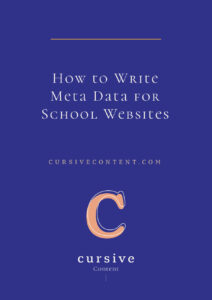How to Write Meta Data for School Websites

SEO is a vast and complex field, at once very important and very foreign to school marketers.
Those who realize the limitations of their expertise often shy away from it, because it is big, constantly evolving… and a little intimidating.
But there is one important aspect of SEO that most school marketers will encounter – and that’s meta data.
Thankfully, meta data development doesn’t require years of experience or an in-depth understanding of Google’s algorithms. An understanding of the basics will help you craft meta data for your school website without turning to (or turning into) an SEO expert.
Before we get started, let’s address the question you might be hesitant to ask: what is meta data, anyway?
Meta data is data that describes other data. Your website’s meta data describes the content that is on each page of your website.
Website meta data tells search engines like Google exactly what your school website is about– which then helps your content appear in the appropriate search results.
When you’re writing or revising your school website, you will also need to craft meta data for each page. Meta data includes two main components: meta titles and meta descriptions. But before you begin writing those, you need to start with a little research.
STEP 1: KEYWORD RESEARCH
What it is: A keyword is a word or phrase used in an internet search (in other words: it’s the word or words people type into Google). The words people type into Google matter to your school because of those fancy algorithms Google has running behind the scenes that help them return search results.
Why it matters: Search engines check the words on your website (which includes on-page copy as well as meta data) for the words people use in search– and if your website contains a keyword, the more likely it is that your website will rank high in searches for that word.
How to get started: It is important to do keyword research before you begin writing your school website’s meta data (you should actually do keyword research before you begin writing any content, so that keywords are included in both the page content and the meta data), to ensure you are using the words and phrases that will drive your ideal audience to your page.
Google’s Keyword Planner is a helpful tool that provides real data that can help guide you to the best keyword for each website page. When writing, you’ll naturally use a variety of words to describe your school and its academics, programs, activities and approach. Once you’ve done keyword research, you are aware of the best keyword to use and can weave those into your writing, both on the page and in the meta data.
STEP 2: PAGE TITLE
What it is: A short description of the page’s content – just like how this blog post’s title sums up the information you will find within this post.
Where it appears: The page title shows up in three significant places. Using Cursive’s own website as an example, here’s how page titles appear.
At the top of your browser window and in browser tabs:
![]()
In search results, like this:

On social networks when a link to the page is used, like this example from Facebook:

Ideal length: As a general rule, aim for about 55 characters. Google typically shows 50-60, but this is based on pixels (512 pixels, to be exact) rather than an exact character count. This tool from Moz can be very helpful when you’re close to the limit– it shows exactly how titles appear in a Google search.
How to write a page title: Consider the three places where it will be shown. When seen in a browser tab, it helps the user know what page they have open. In search results, the page title can help the audience determine if the page’s content is what they are looking for. On social networks, it can also help determine if the link is interesting enough to click.
Your page title needs to be equally compelling in all three circumstances. It needs to accurately convey the topic of the page and should contain keywords whenever possible, since this will help the page rank higher in Google results. We typically recommend that you develop page titles using the same convention across your entire website. A common convention (and one that we use) is:
Page Descriptor with Keyword | School Name
Including the school name in the title is helpful in all three instances where the page title will appear—it can help lend greater authority to the relevance of a link and helps the user who sees it in the browser tab (especially if, like so many of us often do, they have a dozen tabs open).
STEP 3: META DESCRIPTION
What it is: The meta description provides a brief description of the content on a given page.
Where it appears: In search results. It’s the description you see below the page title and URL; the thing you read to determine if you want to click through.
Ideal length: Between 150-160 characters at most. Search engines will cut off your descriptions if they are any longer.
How to write a meta description: While a page title needs to get the attention of search engines, a meta description needs to catch the eye of the person doing the searching. Think of a meta description as both a summary of the content found on the page AND a call to action. It needs to provide an explanation of what the page is about and compel the audience to click through to read the content.
It’s ok to pull your meta description directly from the copy. A great description might already exist within your page content, it just might need a little bit of tweaking to add a call-to-action, and to ensure it fits within the character count.
Here, we see how Cursive’s “Work With Cursive” page has a short, clear, compelling description that doesn’t get truncated.

Remember that you’ll need a page title and meta description for each page of your website. At Cursive, we typically make this an integrated part of the website copywriting process, to ensure that all elements of the page are written cohesively and so the page content is kept together in one location. This makes it easy to load page content when you’re ready to hit publish on that beautiful new (or updated) school website.
You don’t need to be an SEO expert to craft valuable meta data for your school website. An understanding of how each element is used and how to use it to your advantage is enough to write meta titles and meta descriptions that help increase the visibility and findability of your content– and ultimately, your school.
MORE ARTICLES
-
 Clarity in 50 Words or Less: How to Write Your School’s One-Sentence Story
Clarity in 50 Words or Less: How to Write Your School’s One-Sentence Story -
 The 4 Building Blocks of a Strong School Story (and Why AI Needs Them)
The 4 Building Blocks of a Strong School Story (and Why AI Needs Them) -
 How to Stop ChatGPT from Making Your School Sound Generic
How to Stop ChatGPT from Making Your School Sound Generic -
 What Should Your School Do with Its Blog Now That AI Is Changing Search?
What Should Your School Do with Its Blog Now That AI Is Changing Search? -
 What Is Your Private School’s Bold & Unifying Big Promise?
What Is Your Private School’s Bold & Unifying Big Promise? -
 Viewbook Best Practices for Private Schools
Viewbook Best Practices for Private Schools -
 AI Writing Prompts to Power Private School Storytelling
AI Writing Prompts to Power Private School Storytelling -
 How to Write a Magnetic Private School “About” Page
How to Write a Magnetic Private School “About” Page

